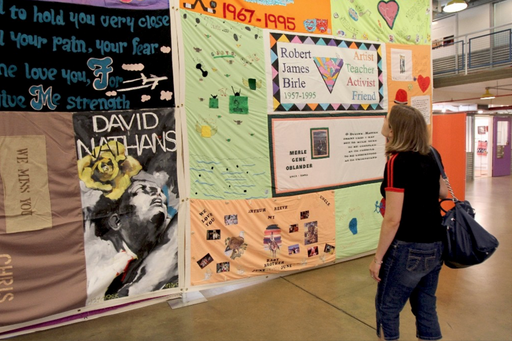The AIDS Memorial Quilt is a powerful and moving tribute to those who have died from AIDS-related illnesses. It is the world’s most important example of communal folk art and a monument and a means of spreading awareness of the AIDS crisis.
The original plan for the quilt was to create a remembrance to honour the lives lost to AIDS in 1987. Gay rights activist Cleve Jones came up with the idea while participating in a candlelight memorial march in San Francisco. During the October 1987 National March on Washington for Lesbian and Gay Rights, the quilt was first exhibited at the National Mall in Washington, D.C.
Each panel in the quilt is 3 feet by 6 feet or roughly the size of a cemetery. These panels are the work of persons living with AIDS as well as friends and family of those who has passed away from the illness. The panels create a personal and sentimental monument because they frequently contain comments, photos, and private mementoes. The quilt became more significant as the AIDS crisis ravaged communities all around the world. It matured into a memorial and a rallying cry for more schooling, research, and assistance for the HIV/AIDS community. The patchwork is a powerful reminder of the epidemic’s human cost and has been displayed worldwide at different venues and events.
Every time the quilt is exhibited, it is placed in expansive parts, enabling individuals to stroll among the panels and contemplate the lives they depict. The quilt is owned by and will continue to be managed and cared for by the NAMES Project Foundation. The AIDS Memorial Quilt has been instrumental in eradicating stigma, promoting HIV/AIDS awareness, and paying tribute to the lives of those impacted by the illness. It performs as proof of the spirit and resiliency of the epidemic-affected populations.
Story of The AIDS Memorial Quilt
The AIDS Memorial Quilt began as a grassroots campaign to increase awareness of the AIDS epidemic and to honour and commemorate those who died from the disease in the 1980s. These panels are frequently made by the deceased’s friends, relatives, or loved ones, making the quilt an incredibly sentimental and intimate remembrance.
One sufficient way to spread awareness of the HIV/AIDS epidemic is through the AIDS Memorial Quilt. It helps people learn the scope of the disaster and gives a human face to the numbers. Every panel contributes to a collective narrative highlighting the disease’s human cost while telling a distinct story.

The names and life stories of those who lost their lives to AIDS are recorded on the patchwork, which acts as a historical record of the pandemic. It portrays the diversity of those impacted, representing a range of vocations, backgrounds, and lifestyles. To confront the HIV/AIDS epidemic, activism and advocacy efforts have been greatly aided by the quilt. It has been on display on numerous occasions and places worldwide, calling attention to the need for more financing, research, and assistance for individuals impacted by the illness.
The quilt offers a place of rehab and remembering for people who have lost friends, family, or lovers to AIDS. It enables people to grieve openly, honour the lives of the deceased, and find comfort among a group of people who had similar experiences. Amid a worldwide health crisis, the quilt represents unity and solidarity. It has been exhibited in several places, including Washington, D.C.’s National Mall. It has toured many nations, promoting a feeling of interconnectedness across borders and collective accountability in the battle against HIV/AIDS.
The quilt can be used as a teaching tool to help students learn about the background of the HIV/AIDS crisis. It is often used to inform people about the impacts of the infection and the significance of testing, prevention, and support in schools, museums, and public gatherings. The AIDS Memorial Quilt is a potent and mournful memory of the lives lost to HIV/AIDS, a wake-up call to the troubles still facing the disease, and an inspiration to keep fighting it locally and internationally.
Socio-Political Impact of AIDS Memorial Quilt
The quilt raised attention to the AIDS epidemic at a period when prejudice and stigma were pervasive. It humanised the epidemic by showcasing individual faces and personal tales, dispelling myths and biases related to HIV/AIDS. The quilt has been a potent campaigning tool when it has been on display at essential outlets and occasions. It has been engaged to advocate for more financing for HIV/AIDS education, care, and research. The quilt’s notoriety has aided in gaining funds for programmes addressing the world health emergency.
The AIDS Memorial Quilt has influenced HIV/AIDS policies. The patchwork has served as a symbol for activists and supporters fighting for expanded access to treatment, anti-discrimination legislation, and comprehensive healthcare policies. It has helped to create public health policies that are more knowledgeable and caring.
The LGBTQ+ community and its allies have found the quilt a unifying symbol. It strengthens the bonds of solidarity between the supporters and those impacted by the disease. Advocacy activities have significantly benefited from this sense of community, which has amplified voices and pushed for change.
To spread knowledge about HIV/AIDS prevention, the quilt has been employed as an instructional tool; telling the tales of those who have passed away from the illness promotes conversations about responsible behaviour, testing, and safe procedures. This educational component supports more significant public health initiatives to stop HIV from spreading.
The AIDS Memorial Quilt is not confined to one location; it has travelled nationally and internationally. Its global presence has helped connect diverse communities affected by HIV/AIDS, emphasizing the interconnectedness of the epidemic and the need for a coordinated global response.
Featured image: aidsmemorial.org
Dread Scott: Provoking Dialogue and Confronting Injustice Through Transformative Art





